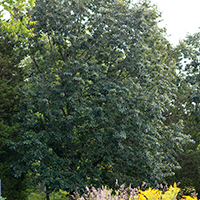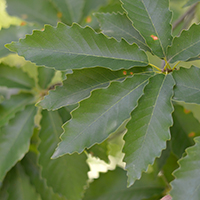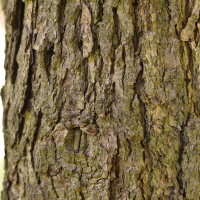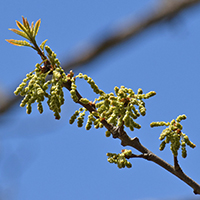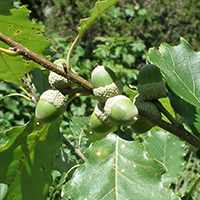What chinquapin oak looks like
Size and shape
- Reaches 30 metres high.
- Straight trunk up to 60 centimetres in diameter.
Leaves
- Glossy green leaves (10 to 18 centimetres).
- Bottoms are pale green.
- Narrow and coarsely toothed with pointed tips.
Bark
- Pale brownish grey.
- Thin, narrow and flaky scales.
Flowers
- Male flowers are small catkins.
- Female flowers are small and grow as individuals or in clusters.
- Flowers emerge in late spring.
Fruit
- Acorns are short (12 to 25 millimetres) and covered in small scales.
- Cap covers one third to one half of the acorn.
Where chinquapin oak is found
Chinquapin oak is uncommon in Ontario but can be found in Southwestern and Southeastern Ontario near the Great Lakes and St. Lawrence River.
What you need to know to grow chinquapin oak
- Moisture: grows best in well-drained soil but will tolerate wet conditions and can grow along streams.
- Soil: grows best on rocky sites such as shallow soil over limestone, calcareous soils and stable forested sand dunes.
- Shade: requires full sun but can tolerate some shade when young.
- Cautions:
- Planting: chinquapin oak has a long taproot and can be difficult to transplant.
- Disease: oak wilt is caused by an invasive fungus that has been found in Southern Ontario. To minimize the risk of oak wilt, save pruning for before April and after July, when beetles thought to transport the fungus are less active.
Benefits and uses of chinquapin oak
Wildlife benefits
Chinquapin oak acorns provide food for many species, including:
- wild turkey
- grouse
- white-tailed deer
- chipmunks
- squirrels
The leaves are also commonly eaten by cattle.
Commercial uses
Like other oak species, chinquapin oak has durable, dense wood. It is commonly used for fencing and fuel. Chinquapin oak wood has also been used for railroad ties across the Midwestern United States.
Fun facts about chinquapin oak
- Chinquapin oak acorns can be eaten raw and taste sweet.
- Chinquapin oak can be mistaken for dwarf chinquapin oak as they can both grow under harsh conditions.
- Chinquapin oak trees can produce almost 10 million acorns over their lifetime.
Updated: January 10, 2024
Published: August 22, 2023
